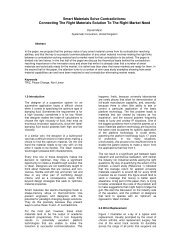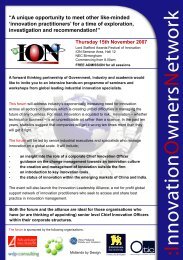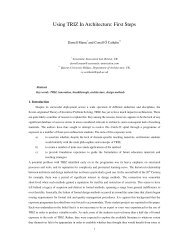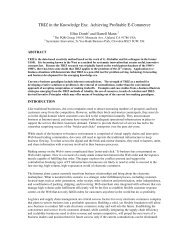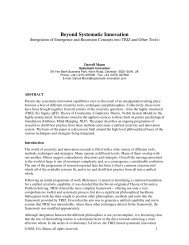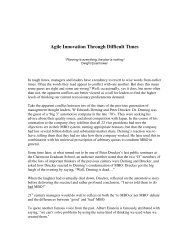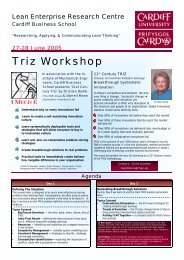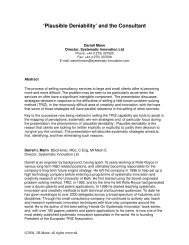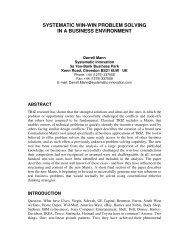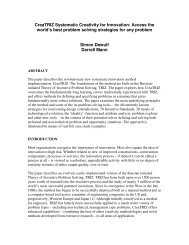TRIZ-Based Root Cause Failure Analysis For Hydraulic Systems
TRIZ-Based Root Cause Failure Analysis For Hydraulic Systems
TRIZ-Based Root Cause Failure Analysis For Hydraulic Systems
Create successful ePaper yourself
Turn your PDF publications into a flip-book with our unique Google optimized e-Paper software.
Darrell L. Mann, 1 and Edmund J. Hughes 2<br />
<strong>TRIZ</strong>-<strong>Based</strong> <strong>Root</strong> <strong>Cause</strong> <strong>Failure</strong> <strong>Analysis</strong> <strong>For</strong> <strong>Hydraulic</strong><br />
<strong>Systems</strong><br />
Reference: Mann, D.L., Hughes, E.J., "<strong>TRIZ</strong>-<strong>Based</strong> <strong>Root</strong> <strong>Cause</strong> <strong>Failure</strong> <strong>Analysis</strong> <strong>For</strong><br />
<strong>Hydraulic</strong> <strong>Systems</strong>," <strong>Hydraulic</strong> <strong>Failure</strong> <strong>Analysis</strong>: Fluids, Components, and System<br />
Effects, ASTM STP 1339, G.E. Totten, D.K. Wills, and D. Feldman, Eds., American<br />
Society for Testing and Materials, West Conshohocken, PA, 2000.<br />
Abstract<br />
<strong>Analysis</strong> of root cause failure mechanisms in hydraulic systems suggests that poor<br />
overall system specification, leakage and contamination issues are the dominant failure<br />
contributors. The paper examines how the Russian Theory of Inventive Problem Solving,<br />
<strong>TRIZ</strong>, is beginning to be applied in the specification and design of hydraulic systems and<br />
components. Several of the key <strong>TRIZ</strong> tools, methods and strategies – Contradiction<br />
elimination, Ideal Final Result, Trends of Evolution, and Function <strong>Analysis</strong> have been<br />
deployed on a number of case study examples. These examples include leak-free<br />
coupling and self-cleaning filter component design studies, and an examination of whole<br />
system energy management issues.<br />
Keywords<br />
<strong>TRIZ</strong>, system specification, leakage, contamination<br />
Introduction<br />
<strong>Hydraulic</strong> systems are robust. Robust but not invincible. The hydraulics industry<br />
has, generally speaking, been quick to capitalise on the former, and slow to recognise the<br />
latter. Rising customer expectations on parameters like time between overhaul and time<br />
between failure have reached a point where they often exceed the inherent capability of<br />
today’s hydraulic systems. Existing design paradigms for individual components are no<br />
longer appropriate. Existing design paradigms for integrated hydraulic systems are no<br />
longer appropriate. The answer does not lie in the traditional route of adapting existing<br />
designs with after-the-event remedies; these make the product more expensive<br />
1<br />
Systematic Innovation, 5a Yeo-Bank Business Park, Kenn Road, Clevedon BS21 6UW<br />
UK. Darrell.mann@systematic-innovation.com<br />
2 Research Officer, Department of Mechanical Engineering, University of Bath,<br />
BA2 7AY, UK.
and, more often than not, shift the problem rather than remove it. After-the-event design<br />
is the ultimate compromise.<br />
Design for reliability – ‘design for robustness’, ‘through-life design’ – means<br />
thinking about failure issues on day one. <strong>Cause</strong>s of failure in hydraulic systems are,<br />
qualitatively at least, relatively well known. The two single biggest failure issues are<br />
leakage and contamination. The single biggest root failure cause is poor specification.<br />
<strong>TRIZ</strong> is an extremely powerful Russian problem definition and problem solving<br />
method. <strong>TRIZ</strong> is built on the knowledge of mankind accrued across the global patent<br />
database. It is also a methodology built on a ‘design without compromise’ premise. It<br />
guides engineers towards getting the specification right. It guides engineers out of<br />
existing design paradigms into constructive and valuable new ones.<br />
The objective of the paper is to demonstrate how <strong>TRIZ</strong> can and has been used to<br />
design inherently better – more reliable – hydraulic components and systems. A number<br />
of case study examples are presented. Each study focuses on one or more of the key<br />
failure related issues:-<br />
• Using <strong>TRIZ</strong> to get the specification right – a look at system heat management<br />
from the perspective of both overall fluid power system technology evolution<br />
trends versus heat exchanger design strategy, using an example from a<br />
mobile application<br />
• Using the Function <strong>Analysis</strong> and Ideal Final Result parts of <strong>TRIZ</strong> to conduct<br />
upfront root cause failure analysis of systems, and then using ‘Trimming’<br />
techniques to derive the ‘right’ minimum life-cycle cost design solution – an<br />
application looking at the design of a simple, cheap, self-cleaning filtration<br />
system.<br />
• Case studies examining the use of <strong>TRIZ</strong> root-cause contradiction elimination<br />
methods to help in the realisation of leak-free coupling and connector<br />
designs.<br />
Most real world organisations are caught in a constant battle to produce ever more<br />
and ever better products with ever fewer resources.<br />
Fewer engineers with more to do is a combination which usually leads to a strong<br />
focus on fire-fighting today’s problems with today’s tools and techniques. The ‘quick-fix’<br />
is very much the order of the day.<br />
All too often, the ‘quick fix’ turns out to be no fix at all. At least not in terms of<br />
overall business performance. The reason for this is very simply that by fixing the<br />
symptoms of a problem – rather than the root causes – we tend to generate a new solution<br />
which is fundamentally more expensive to produce than the old one. Adding a palliative<br />
is very much easier than finding a root cause. Especially when time is short.<br />
Russian naval officer and engineer Genrich Altshuller had the idea that all of the<br />
examples of ‘good’ design practice – the designs which succeeded in achieving<br />
maximum functional benefit from minimum use of resource – followed common solution<br />
strategies. He also felt that these strategies could be systemised. And so Teorija<br />
Rezhenija Inzhenernyh Zadach (<strong>TRIZ</strong>) – or, in English, ‘Theory of Inventive Problem<br />
Solving’, was born.<br />
<strong>TRIZ</strong> research began in 1946 with Genrich Altshuller’s hypothesis that there are<br />
universal principles of invention that are the basis for creative, technology advancing,<br />
innovations [1]. Altshuller believed that if these principles could be identified and
codified, they could be taught to people; and thus could make the process of invention<br />
more predictable. <strong>TRIZ</strong> research has proceeded in several stages over the last 50 years,<br />
now accumulating over 1500 person-years of scientific study and going far beyond<br />
Altshuller’s initial hypothesis. The three primary findings of the research are:<br />
1. Problems and solutions were repeated across industries and sciences<br />
2. Patterns of technical evolution were repeated across industries and<br />
sciences<br />
3. Significant innovations used scientific effects outside the field where they<br />
were developed.<br />
Much of the practice of <strong>TRIZ</strong> consists of learning these repeating patterns of<br />
problems-solutions and patterns of technical evolution, and methods of using scientific<br />
effects, and applying the general <strong>TRIZ</strong> patterns to the specific situation that confronts the<br />
developer. Figure 1 describes this process graphically.<br />
<strong>TRIZ</strong><br />
GENERIC<br />
PROBLEM<br />
<strong>TRIZ</strong><br />
GENERIC<br />
SOLUTION<br />
SPECIFIC<br />
PROBLEM<br />
SPECIFIC<br />
SOLUTION<br />
Figure 1 – The General Model <strong>For</strong> <strong>TRIZ</strong> Problem Solving<br />
Altshuller’s work on problem classification and the discovery that there are only a<br />
very small number of Inventive Principles available to the engineer is already profoundly<br />
changing the systematic innovation picture. That there are only these small number of<br />
principles has, for example, meant their systemisation in software form has been<br />
relatively easy. The emergence of a number of commercial packages built around <strong>TRIZ</strong><br />
ideas [2] is therefore not surprising.<br />
This concept of identifying the contradictions in a design and correlating them to<br />
how other inventors have solved the same types of problem is but one element of what is<br />
now a much broader <strong>TRIZ</strong> methodology covering:-<br />
• Trends of technology evolution classified in terms of generic functionbased<br />
parameters.<br />
• Classification of physical, chemical, and mathematical effects into a<br />
function-based database structure.<br />
• The concept of ‘Ideal Final Result’; a means of first helping to define the<br />
problem to be solved and then a method for establishing the route towards<br />
the optimum (compromise-free) solution to that problem.<br />
• A Function <strong>Analysis</strong> system modelling methodology and a corresponding<br />
database of what Altshuller described as ‘Standard Inventive Solutions’.
• A method – known as the Algorithm for Inventive Problem Solving<br />
(ARIZ) – through which inventors are able to classify and discover<br />
effective means of solving complex problems.<br />
The paper examines the Effects, Contradictions, Trends, Ideal Final Result and<br />
Function <strong>Analysis</strong> parts of <strong>TRIZ</strong> from a fluid power industry perspective, and looks at<br />
how <strong>TRIZ</strong> is being applied at the University of Bath to shift a number of design<br />
paradigms surrounding seemingly intractable problems.<br />
Case Study 1: Flanged Joint/Leak-Free Coupling<br />
In order to demonstrate some of the differences between the traditional design<br />
approach and the <strong>TRIZ</strong> approach, it is useful to look at the example of a flange joint<br />
design.<br />
A flange joint is designed to carry a variety of loads and moments whilst<br />
simultaneously forming a satisfactory seal. Traditional logic says that if a flange is<br />
designed and tested and is found to leak, the way to rectify that leak is to do one of three<br />
things: 1) increase the bolt torque, 2) increase the number of bolts, or 3) add a gasket of<br />
some sort. Ninety-nine times out of a hundred, the ‘quick-fix’ solution to the leaking<br />
flange problem would be to do one of these things. In each case, however, although the<br />
immediate problem may have been fixed, the designer has merely solved the problem at<br />
the expense of something else in the design. Increasing bolt torque has degraded life<br />
expectancy of the joint, increasing the number of bolts has increased the overall weight<br />
and maintenance time, and adding a gasket has increased assembly and maintenance cost,<br />
and decreased life. The designer has in effect done no more nor less than find a different<br />
point on the same trade-off characteristic (Figure 2).<br />
high<br />
Number<br />
of Bolts<br />
⇒<br />
bad<br />
Weight<br />
or<br />
Convenience<br />
of Use<br />
low<br />
good<br />
Leakage Performance<br />
bad<br />
good<br />
good<br />
bad<br />
Leakage Performance<br />
Figure 2 – Typical Conflicting Parameter Design Trade-Off Scenario<br />
In <strong>TRIZ</strong> terms, the designer has designed by compromise. Given the same leaking<br />
flange scenario, <strong>TRIZ</strong> gets the designer to examine the design from a compromise-free<br />
perspective. In this case, ‘design without compromise’ will have been achieved if a
design with good leakage performance AND a small number of bolts (low weight, high<br />
convenience of use) can be devised. Identification of this type of apparently paradoxical<br />
contradiction statement is an important aspect of <strong>TRIZ</strong>.<br />
The Contradiction Matrix [3] (Table 1 at end of paper) provides a potent means<br />
of connecting such statements to inventive principles (Table 2 at end of paper) in which<br />
other engineers have managed to solve similar generic types of contradiction.<br />
Reference [4] details the process by which the flange joint problem may be<br />
solved without compromise. Needless to say, it is possible to design a better seal with<br />
fewer bolts. The answer is illustrated in Figure 3. Tests on this type of flange joint [5]<br />
have demonstrated that it is actually possible to halve the number of bolts relative to<br />
conventional design practice.<br />
Figure 3 - Fluid-Tight Joint With Inclined Flange Face, US Patent 5,230,540<br />
Leak-Free Coupling - No designer sets out to design a coupling that will leak. And yet<br />
over 300 million litres of hydraulic fluid go missing in Europe every year. Theoretically<br />
at least, the design picture is a well understood one; there are known design loads, L, and<br />
known material characteristics, S, and each has some kind of statistical spread – due to<br />
the various uncertainties present in systems – variations in material properties, variations<br />
in operating condition, degradation over time, etc. Design of a leak-free coupling, may be<br />
achieved by ‘simply’ ensuring there is no overlap between the load and strength<br />
characteristics – Figure 4.<br />
The reality, of course, is that the two characteristics do overlap. The overlap<br />
occurs because – traditionally – the designer is also expected to keep a keen eye on other<br />
design requirements like cost, weight and manufacturability. Compromise occurs as the<br />
designer attempts to find the best balance between each parameter. Quite often cost – and<br />
particularly ‘initial purchase cost’ – becomes the dominant selection criterion; and<br />
leakage performance becomes compromised.
Figure 4 – Load versus Strength –Ideal Design State<br />
The <strong>TRIZ</strong> root-cause compromise-elimination approach allows designers to<br />
escape from the traditional design strategy i.e., balancing different parameters (Figure 5).<br />
bad<br />
Parameter<br />
B<br />
Traditional Design<br />
Strategy<br />
good<br />
good<br />
<strong>TRIZ</strong><br />
Parameter A<br />
bad<br />
Figure 5 – Traditional v <strong>TRIZ</strong>-based Approach to <strong>Root</strong>-<strong>Cause</strong> Design Contradictions<br />
The inclined flange face idea of Figure 3 is one such idea where the traditional<br />
coupling design paradigm may be modified in order to achieve good leakage performance<br />
and a low weight, low cost solution. The same contradiction-elimination perspective may<br />
also yield other significant root-cause problem solutions in other aspects of fluid power<br />
system design for true leak-free performance.<br />
Case Study 2: Filters<br />
A common starting point in <strong>TRIZ</strong> thinking is to look at the compromises and<br />
trade-offs present in the state of the art. In the case of filtration systems, those trade-offs<br />
include:-
* PHYSICAL SIZE * MESH SIZE<br />
- contaminant holding capacity, - circuit protection versus filter life<br />
- pressure loss versus weight<br />
* MEDIA TYPE * OPERATING PRESSURE<br />
- cleanable versus disposable - size versus stability<br />
* BYPASS/NO-BYPASS<br />
Recognition of the trade-offs is a very good initial step towards removing them.<br />
Altshuller’s trends of technology evolution provide one of the ways of determining how<br />
such trade-offs might be removed.<br />
Strictly speaking not one of Altshuller’s discoveries, but nevertheless consistent<br />
with all the trends he did discover is the universal trend towards increasing product<br />
‘ideality’. This idea was first discussed by Larry Miles [6]. Miles defined ‘ideality’ or<br />
‘value’ as:<br />
Value = Benefits / (Costs + Penalties)<br />
The ‘law’ of increasing product ‘ideality’ in the context of fluid power filtration<br />
says that future systems will evolve towards greater benefit (better circuit protection),<br />
lower cost (cost of filter, life-cycle cost of system into which filter is designed) and<br />
reduced operating penalties (lighter filters, reduced volume, better disposability, etc).<br />
None of these should appear particularly surprising.<br />
Miles’ ideas are commonly expressed in terms of the S-curves of product<br />
evolution. S-curves show trends of increasing ideality through successive generations of<br />
product evolution.<br />
Altshuller’s trends of evolution discoveries are based primarily on analysis of the<br />
global patent database and have thus concentrated on the physical manifestations<br />
distinguishing one product generation from another. Among a host of patterns of<br />
evolution spotted by Altshuller [1] is the example of ‘trimming’.<br />
The ‘Trimming’ evolution trend (Figure 6) says simply that products will evolve<br />
to contain progressively fewer components. Generally speaking, the reduction will<br />
eventually be achieved with no decrease in product functionality.<br />
Figure 6 - ‘Trimming’ Evolution Trend<br />
Thinking now in terms of some of the current filtration system trade-offs and<br />
these possible evolutionary trends, it becomes possible to see how the latest generation of<br />
‘core-less’ filters have evolved.
Conventional disposable filters involve disposal of the filtration medium and the<br />
supporting structure (element support, bowl, etc). Disposal occurs because the filtration<br />
medium is filled with contaminant. The support structure around the medium, however,<br />
has much useful life left. The ‘increasing value’ and ‘Trimming’ trends suggest that the<br />
support structure should be made re-usable and only the filtration medium is disposed of.<br />
Which is the exact principle in, for example, US patent 5,762,788 (Figure 7).<br />
The ‘core-less’ filter is indeed a useful - perhaps 'generational' – advance in<br />
filtration technology. It ought to be possible to employ the evolution trend patterns to<br />
project further advances beyond this core-less unit.<br />
Filter Medium<br />
Re-Usable<br />
Bowl<br />
Figure 7 - US Patent 5,762,788 ‘Fluid Filter Having Re-Usable Filter Housing and a<br />
Replaceable Coreless Filter Element’<br />
Altshuller, conceived the Ideal Final Result (IFR) philosophy as another means of<br />
assisting in the derivation of future technology advances. In effect, the IFR approach is a<br />
way of encouraging designers to look at the furthest evolution along the trend paths.<br />
There are a number of ways in which the IFR of a product can be developed. One<br />
such means is to pass through the following sequence of questions:-<br />
1) What is the final aim?<br />
2) What is the IDEAL FINAL RESULT?<br />
3) What is the obstacle to this?<br />
4) Why does this interfere?<br />
5) Under what conditions would the interference disappear?<br />
(What resources are available to create these conditions?)<br />
In theory, passing through the questions successfully should lead to the required<br />
IFR solution – at least conceptually. In the case of the filter, for example, the following<br />
answers may emerge:<br />
1) What is the final aim?<br />
To remove contaminant from circuit (‘make the circuit invulnerable’ to<br />
contaminant could also be considered an effective strategy);<br />
2) What is the IDEAL FINAL RESULT?<br />
Contaminant removes itself from the circuit (Figure 8);
OIL +<br />
Contaminant<br />
OIL<br />
Contaminant<br />
Figure 8 - Filtration System ‘Ideal Final Result’<br />
3) What is the obstacle to this?<br />
Contaminant follows the oil flow.<br />
4) Why does this interfere?<br />
Since contaminant follows the flow, there is no means of removing it from the<br />
flow stream (except by using a barrier that stops contaminant but does not stop<br />
flow).<br />
5) Under what conditions would the interference disappear? (What resources are<br />
available to create these conditions?)<br />
contaminant able to move relative to flow<br />
(contaminant has momentum, mass, shape, magnetic properties, etc).<br />
Asked how many ways there might be to make a particulate contaminant ‘move’,<br />
evidence suggests engineers working in the particulate area might be able to name three<br />
or four.<br />
Thinking more globally, other evidence suggests that the majority of engineers<br />
have working knowledge of perhaps 20-30 physical, chemical or mathematical effects,<br />
and maybe a passing knowledge of as many again.<br />
The Invention Machine® software contains a massive database of such effects.<br />
One of the advantages of this database is in following the lead provided by Altshuller to<br />
classify the database in terms of function. So, for example, the database collects all the<br />
known ways of making particles move under a single heading. At present the number of<br />
ways of moving particles contained in the database is 33 (Table 3).<br />
Some of these Effects will turn out to be more appropriate to the problem at hand<br />
than others. It is the job of the engineer to determine which is which. This will probably<br />
involve a significant amount of work. Likewise, the process of transforming a promising<br />
effect into a viable engineering design is equally tortuous.<br />
In some instances, the technology associated with the effect will be insufficient to<br />
carry out the required function. <strong>For</strong> example, gravity alone will be insufficient to<br />
separate, say, a 3µm particle from oil in an acceptable (for a filtration system) period. In<br />
these cases, engineers are forced into a programme of research to improve the effect, or,
more likely, there will be a need to back away from the IFR towards a solution which is<br />
viable. (See Reference [7] for an example of how such a process works in practice).<br />
Table 3 – Means of ‘Moving Particles’<br />
* Gravity * Laminar Flow * Resonance<br />
* Inertia * Funnel Effect * Vibration<br />
* Acoustic Vibration * Hyperboloid * Turbulent Flow<br />
* Birds Beak Effect * Ion Conductivity * Electrets<br />
* Corona Discharge * Mobius Strip * Photophoresis<br />
* Coulomb’s Law * Magnetic Explosion * Thermophoresis<br />
* Friction * Photophoresis * Triboelectricity<br />
* Diffusion From Limited Source * Resonance * Pascal Law<br />
* Boundary Layer Entrapment * Ferro-magnetism * Ranque Effect<br />
* Atomic Beam-Stimulated Desorption * Diamagnetism * Fluidisation<br />
* Diffusion Depth * Reuleaux Triangle * Funnel Effect<br />
* Dopant Segregation * Laminar Flow * Electrophoresis<br />
Meanwhile, in the case of the ‘contaminant removes itself’ Ideal Final Result, it<br />
appears that a solution may well be possible.<br />
The problem is amenable to analysis by yet another of Altshuller’s <strong>TRIZ</strong> tools –<br />
the S-Field <strong>Analysis</strong> part of <strong>TRIZ</strong> [1]. S-Fields are Altshuller’s attempt to describe<br />
inventive problems in a manner analogous to chemical formulae.<br />
‘Fields’ are external forces that may be applied to Substances (the ‘S’ in S-Field).<br />
There are six basic families of field:<br />
• Gravitational<br />
• Electromagnetic (electrical/magnetic)<br />
• Nuclear – weak interaction<br />
• Nuclear – strong interaction<br />
• Mechanical<br />
• Thermal.<br />
Taking S1 to represent a typical particulate contaminant, we are able to draw an S-<br />
Field for the current situation:<br />
F<br />
S1<br />
According to the IFR, we require to impart some kind of force onto the particle in<br />
order to separate it from the force. The dashed arrow indicates that this is currently an<br />
‘insufficient action’. <strong>Analysis</strong> of the available Fields along with use of the Effects<br />
database does not appear as though a (practical) field with sufficient force can be<br />
obtained. Probably the closest would be to use an electrical field (cf. electrostatic
precipitator separation devices), although the low velocity requirements of such systems<br />
mean they would be too bulky (and expensive) for a fluid power application.<br />
This ‘insufficient action’ S-Field scenario is one of a number of problem types<br />
classified by Altshuller. <strong>For</strong> each type of problem, he identified a number of Standard<br />
Inventive Solutions. <strong>For</strong> this particular case, one of the suggested solutions is, ‘if it is not<br />
possible to impart sufficient Field to the Substance directly, then impart it through a<br />
second substance'. The S-Field map for this suggestion is illustrated in Figure 9.<br />
F<br />
F<br />
S 1 S 1 S 2<br />
Figure 9 - S-Field for ‘Ideal Final Result’ Fluid Power System Filtration Device<br />
Preferably, the second ‘substance’ S2 will be an existing part (or a modification of<br />
an existing part) of the system surrounding the separator. Ideally, the Field applied to S2<br />
will be the simplest of the six possibilities.<br />
<strong>Analysis</strong> of the ‘self-cleaning filter’ based on this S-Field has in fact revealed that<br />
a solution does exist. In keeping with the concept of using existing parts of the system<br />
(i.e. the overall fluid power system), preliminary calculations suggest that a self-cleaning<br />
filter offering:<br />
• lower installed volume<br />
• lower pressure loss<br />
• higher pressure loading capability<br />
• low part count (lower than for current barrier filters)<br />
• low cost<br />
can be achieved. In common with other studies [8] this case demonstrates a tendency to<br />
achieve many more side-benefits above and beyond the initial goal (which was ‘selfcleaning’<br />
in this case) if ‘design without compromise’ can be achieved. A self-cleaning<br />
filter based on the S-Field work presented here is currently the focus of a patent<br />
application.<br />
Case Study 3: Evolution of Pump Controls to Improve System Efficiency<br />
In order to develop competitive advantage in what is a highly competitive market,<br />
companies manufacturing mobile equipment e.g., excavators and tractors, are increasing<br />
the sophistication of the hydraulic control systems available to the operator. In doing so<br />
they are adding to the demands on the fluid power system to dissipate energy e.g., within<br />
the reservoir, as increased temperatures effect viscosity and therefore performance levels.
As space restrictions limit the size of the oil reservoir on mobile equipment many<br />
manufacturers have to add additional components such as coolers and fans to control the<br />
heating problem. This increases the complexity of the auxiliary systems and adds<br />
significant cost.<br />
To improve energy efficiency, and counter heating problems, fluid power system<br />
designers have evolved increasingly more sophisticated control strategies. Five control<br />
strategies are described below with the first three being used with fixed displacement<br />
pumps and the final two with variable displacement pumps.<br />
1. Constant flow with maximum pressure limitation - This system always absorbs<br />
considerable power especially when flow is zero. Under this condition all the pump flow<br />
is relieved through the relief valve at maximum system pressure. The pump is therefore<br />
being operated at maximum power and as no useful work is being done by the system, all<br />
the power is dissipated as heat at the relief valve.<br />
2. Constant flow with maximum pressure limitation and automatic unloading -<br />
The efficiency of the basic circuit can be improved by replacing the pressure relief valve<br />
with an unloading valve which automatically unloads the pump whenever the flow in the<br />
system becomes zero. Unlike the pressure relief valve, the unloading valve opens fully<br />
whenever the system pressure reaches its maximum value, permitting pump flow to be<br />
passed directly back to tank.<br />
3. Variable flow with maximum input power limitation - Some systems require<br />
large flows at low pressure and only small flows at high pressure. Considerable saving in<br />
installation cost and overall efficiency can be achieved by using two or more fixed<br />
displacement pumps driven from a single prime mover of limited power. Such a system is<br />
more efficient as by selection of suitable pump flows and pressures the power required to<br />
drive the pumps for both low and high pressure conditions is the same.<br />
4. Constant pressure systems - Introduction of variable displacement pumps<br />
permitted hydro-mechanical control (compensation) to provide a constant pressure<br />
irrespective of the flow demand. An equilibrium is reached when the delivery flow is<br />
such that the delivery pressure is close to (but slightly more than) the pre-set level. Such<br />
an arrangement is, in many applications, more energy efficient than a fixed displacement<br />
pump discharging flow, through a relief valve.<br />
5. Load-sensing systems - There is a definite trend towards greater use of load<br />
sensing control, particularly in mobile applications. The aim is to vary both flow and<br />
pressure to suit the demand of the load, thereby saving energy. Unlike control pressures<br />
for pressure compensated pumps that are sensed inside the pump and reflect all system<br />
pressure variations, control pressures for load-sensing systems are sensed close to the<br />
load. These reflect only variations in that specific load, and are usually sensed at the<br />
motor port of the DCV or at a motor or actuator inlet port.
Two significant design issues arise when examining heat-dissipation in mobile<br />
applications. The first concerns the use of evolution trend prediction to establish whether<br />
or not pump control has anything further to offer in terms of reducing the root-cause heat<br />
generation problem. The second concerns the design of the heat exchanger part of the<br />
system.<br />
Regarding the pump control evolution path, it is useful to examine the<br />
corresponding ‘action co-ordination’ evolution trend observed by Altshuller (Figure 10).<br />
Figure 10 - <strong>TRIZ</strong> ‘Action Co-ordination’ Evolution Trend<br />
It is clear that the pump control evolution story is consistent with the predicted<br />
trends when examining the co-ordination of the actions of the pump and it’s related<br />
control valve, and the corresponding load conditions. System A represents the first step<br />
on the evolution path – in that the action of the pump is uncoordinated with the prevailing<br />
load. <strong>Systems</strong> B, C, and D each represent varying degrees of load/supply co-ordination<br />
consistent with the second evolutionary stage. Load sensing – System E – represents the<br />
third evolutionary stage – at which the load conditions and the pump/valve conditions are<br />
well co-ordinated.<br />
The trend indicates that there is scope for further enhancement in pump<br />
efficiency, and heat generation reduction, through use of design strategies in which<br />
actions occur ‘during intervals’. In the context of the pump control issue, this could either<br />
mean incorporation of some form of heat/energy store or actions to boost heat dissipation<br />
during convenient times during the duty cycle. Alternatively, looking beyond the pump<br />
control system, incorporation of a prime mover with a variable speed capability.<br />
The other side of the heat management problem examines the design of the heat<br />
exchanger system itself. A typical mobile application would use a water-tube oil cooler.<br />
The space restrictions on most mobile applications see the creation of yet another design<br />
contradiction with respect to the design of the exchanger; where the device is required to<br />
be both compact and possess high effectiveness.<br />
Similar heat exchanger contradictions have been comprehensively evaluated from<br />
the <strong>TRIZ</strong> compromise-elimination perspective [9], and it has been shown that significant<br />
improvements in the heat transfer rate per unit volume of heat exchanger can be<br />
achieved.<br />
The mobile system application designer is thus presented with two equally viable<br />
design strategies; one looking at root cause heat generation issues, the other looking at<br />
compromise-eliminating heat dissipation design options. Both are equally valid. The most<br />
appropriate design strategy between the two must be made on a case-by-case basis. The<br />
decision will depend on many trade-offs involving issues like time-to-market, technical<br />
risk and other business-related issues. Alternatively an organisation might seek to<br />
examine ways to use <strong>TRIZ</strong> to address and help to eliminate these trade-offs.
Conclusions<br />
The growing importance of effective innovation and the ever-increasing cost of<br />
product development both mean significant increases in the responsibility borne by<br />
engineers in ensuring we achieve the ‘best’ possible solution to a problem.<br />
The Russian-based <strong>TRIZ</strong> inventive solving methodology offers a number of powerful<br />
new ways of looking at the design process relative to traditional ‘design is a trade-off’<br />
assumptions. It is quite probably the most effective tool available anywhere to assist<br />
engineers in getting to that ‘right’ (compromise-free) design solution at a root-cause<br />
level.<br />
Problem definition is by far the most important part of the problem solving process.<br />
Altshuller’s Ideal Final Result philosophy provides a means of assisting engineers<br />
and designers in this definition process.<br />
The Trends of Evolution <strong>TRIZ</strong> tools provide a very powerful tool for breaking out of<br />
existing design paradigms and into new and exciting ones.<br />
<strong>TRIZ</strong> methods have been successfully used to derive novel leak-free coupling and<br />
connector design concepts.<br />
<strong>TRIZ</strong> methods have been successfully used to derive a patentable ‘self-cleaning’ filter<br />
concept design.<br />
References<br />
[1] Altshuller, G., 'Creativity As An Exact Science', Translated by Anthony Williams,<br />
New York, Gordon And Breach, 1988.<br />
[2] Invention Machine Inc, TechOptimizer V3.1, www.invention-machine.com.<br />
[3] Domb, E., ‘Contradiction Matrix’, <strong>TRIZ</strong> Journal, www.triz-journal.com, June 1997.<br />
[4] Mann, D.L., ‘Case Studies in <strong>TRIZ</strong>: Halving The Number of Bolts in a Flanged<br />
Joint’, <strong>TRIZ</strong> Journal, www.triz-journal.com, November 1998,<br />
[5] Lewis, L., ‘Improvements To Flanged Joints’, ISABE X, Athens, 1989.<br />
[6] Miles, L. D. (1961). ‘Techniques of Value <strong>Analysis</strong> and Engineering’, McGraw-Hill<br />
Book Company, New York NY (Latest printing 1989. Published by Eleanor<br />
Miles-Walker. Sold through SAVE International, 60 Revere Drive, Suite 500,<br />
Northbrook, IL 60006).<br />
[7] Mann, D.L., ‘Case Studies in <strong>TRIZ</strong>: A Re-Usable, Self-Locking Nut’, <strong>TRIZ</strong> Journal,<br />
www.triz-journal.com, April 1999.<br />
[8] Mann, D.L., ‘Case Studies in <strong>TRIZ</strong>: A Helicopter Particle Separator’, <strong>TRIZ</strong> Journal,<br />
www.triz-journal.com, November 1998.<br />
[9] Busov, B., Mann, D.L., Jirman, P., ‘<strong>TRIZ</strong> and Invention Machine: Methods and<br />
<strong>Systems</strong> for Creative Engineering and Education in the 21 st Century’, paper<br />
presented at 1 st International Conference on Advanced Engineering Design,<br />
Prague, May 1999.
Table 1 - 39 Elements of the Contradiction Matrix<br />
1. Weight of moving object<br />
2. Weight of stationary object<br />
3. Length of moving object<br />
4. Length of stationary object<br />
5. Area of moving object<br />
6. Area of stationary object<br />
7. Volume of moving object<br />
8. Volume of stationary object<br />
9. Speed<br />
10. <strong>For</strong>ce<br />
11. Tension, pressure<br />
12. Shape<br />
13. Stability of object<br />
14. Strength<br />
15. Duration of action - moving object<br />
16. Duration of action - stationary object<br />
17. Temperature<br />
18. Brightness<br />
19. Use of energy by moving object<br />
20. Use of energy by stationary object<br />
21. Power<br />
22. Waste of energy<br />
23. Waste of substance<br />
24. Loss of information<br />
25. Waste of time<br />
26. Amount of substance<br />
27. Reliability<br />
28. Accuracy of measurement<br />
29. Accuracy of manufacturing<br />
30. Object affected harmful effects<br />
31. Object generated harmful effects<br />
32. Manufacturability<br />
33. Convenience of use<br />
34. Repairability<br />
35. Adaptability<br />
36. Complexity of device<br />
37. Complexity of control<br />
38. Level of automation<br />
39. Productivity<br />
1. Segmentation<br />
2. Extraction<br />
3. Local Quality<br />
4. Asymmetry<br />
5. Combination<br />
6. Universality<br />
7. ‘Nested Doll’<br />
8. Counterweight<br />
9. Prior Counter-Action<br />
10. Prior Action<br />
11. Prior Cushioning<br />
12. Equi-potentiality<br />
13. ‘The Other Way Round’<br />
14. Spheroidality<br />
15. Dynamics<br />
16. Partial or Excessive Action<br />
17. Another Dimension<br />
18. Mechanical Vibration<br />
19. Periodic Action<br />
20. Continuity of Useful Action<br />
Table 2 - 40 Inventive Principles<br />
21. Skipping<br />
22. ‘Blessing in Disguise’<br />
23. Feedback<br />
24. Intermediary<br />
25. Self-Service<br />
26. Copying<br />
27. Cheap/Short Living<br />
28. Mechanics Substitution<br />
29. Pneumatics and <strong>Hydraulic</strong>s<br />
30. Flexible Shells/Thin Films<br />
31. Porous Materials<br />
32. Colour Changes<br />
33. Homogeneity<br />
34. Discarding and Recovering<br />
35. Parameter Changes<br />
36. Phase Transitions<br />
37. Thermal Expansion<br />
38. Strong Oxidants<br />
39. Inert Atmosphere<br />
40. Composite Materials



